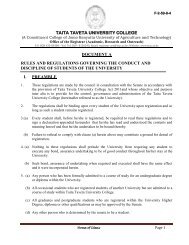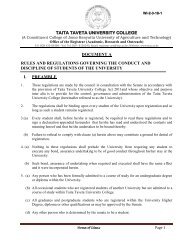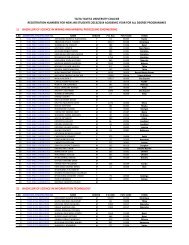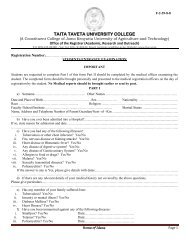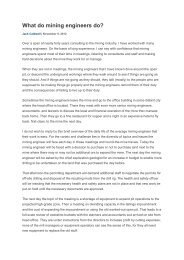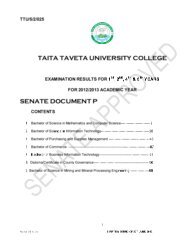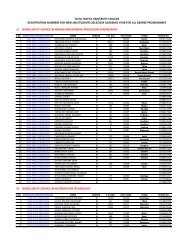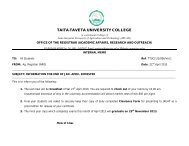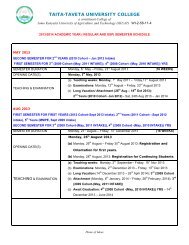Conference Book of Abstracts - Taita Taveta University College
Conference Book of Abstracts - Taita Taveta University College
Conference Book of Abstracts - Taita Taveta University College
- No tags were found...
Create successful ePaper yourself
Turn your PDF publications into a flip-book with our unique Google optimized e-Paper software.
Random stratified sampling technique was used. Transects, 10m by 20m., were set in equalmagnitude in the forest section under the Kenya Wildlife Services (KWS) and The Kenya ForestServices (KFS) (the then Forest Department). Standard herbarium techniques were used tocollect and preserve specimens. A total <strong>of</strong> one hundred and twenty herbal practitioners above theage <strong>of</strong> eighteen years were interviewed. Simple descriptive statistics and Non ParametricCanonical Discriminant Analysis were used to analyse data. About one hundred and sixty eightplant species were documented excluding those that could not be identified. The research showedthat phytomedicines are used by the people and that the people have contributed to thedegradation <strong>of</strong> the forest with the greatest impact felt most on the KFS side and the impact risingwith distance from the „forest Headquarters‟ on either side (KFS or KWS). Certain taxa wereevidently preferred for medicinal use for instance Zanthoxylum gillettii , Trichilia emetica, Oleacapensis and Entadda abyssinica among others. A selected few could serve as flagship speciesfor the conservation <strong>of</strong> this forest. The project recommends in situ and ex situ conservation,phytochemical pr<strong>of</strong>iling and bio-prospecting <strong>of</strong> target taxa in addition to strengthening <strong>of</strong> studieson society and culture It is hoped that the knowledge will help policy makers make policydecisions bordering on biodiversity conservation and sustainable development.Key words: Phytomediciines, medicines, traditional medicine, herbal practitioners, biodiversity,conservation, Forest PolicyCactus pear genetic resources: opportunity for livelihood improvement in the drylands <strong>of</strong>KenyaEunice W. Githae, School <strong>of</strong> Tourism and Natural Resource Management, Narok <strong>University</strong> <strong>College</strong>, P. O. Box,861-20500, Narok, Kenya. Email address: egithaeh@gmail.com, Mobile phone: +254 725 286 095The genus Opuntia (cactus pear) belongs to the Cactaceae family and is highlighted as apotential drought tolerant plant group that is suitable for promoting sustainable cultivationsystems and landscape conservation. It contains about 150 species that are generally dry-habitatspecialists. It is native to Mexico and widely distributed in the Mediterranean area, Central andSouth America, South Africa but some species introduced elsewhere have naturalized and areinvasive. It is most common and widespread in the arid and semi-arid regions due to theirpeculiar adaptations to water scarcity and sun irradiation. Cactus pear was introduced in Kenyain the 1940s-50s as a hedge plant and has now been naturalized in several areas. The plant iscommonly found in agro-climatic zones VI to VII (semi arid to very arid, with average annualrainfall ranging from



